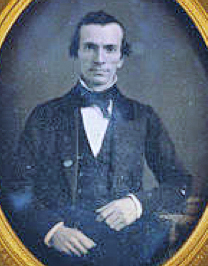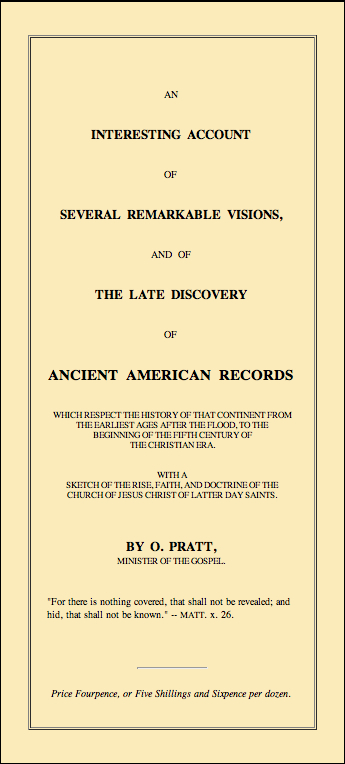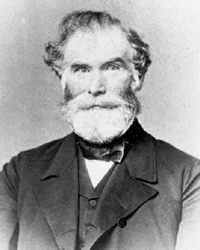Description of the stone box where Moroni deposited the plates.
Picture of Oliver Cowdrey.
 In 1830, Oliver Cowdrey visited the place where the Book of Mormon plates were “deposited”.
In 1830, Oliver Cowdrey visited the place where the Book of Mormon plates were “deposited”.

 Picture of Orson Pratt.
Picture of Orson Pratt.
The following information is taken from a missionary tract written by Elder Orson Pratt, published at Edinburgh, England, in 1841.
“…The place where those records were deposited…shall be given, in the words of a gentleman, by the name of Oliver Cowdery, who has visited the spot.”
Elder Orson Pratt in explaining where the Book of Mormon came from quotes Oliver Cowdery as follows:
"As you pass on the mail-road, from Palmyra, Wayne county, to Canandaigua, Ontario county, New York, before arriving at the little village of Manchester, say from three to four, or about four miles from Palmyra, you pass a large hill in the east side of the road.” “I think I am justified in saying, that this is the highest hill for some distance round…It was…where the record was found to be deposited, on the west side of the hill, not far from the top down its side; and when, [I Oliver Cowdery] ...visited the place in the year 1830, there were several trees standing--enough to cause a shade in summer, but not so much as to prevent the surface being covered with grass--which was also the case when the record was first found."
“…These records were placed by Moroni… some fourteen hundred years buried…they being placed toward the top of the hill… 'A hole of sufficient depth was dug; at the bottom of this was laid a stone of suitable size, the upper surface being smooth; at each edge was placed a large quantity of cement, and into this cement, at the four edges of this stone, were placed erect four others, their bottom edges resting in the cement at the outer edges of the first stone. The four last-named, when placed erect, formed a box; the corners, or where the edges of the four came in contact were also cemented so firmly, that the moisture from without was prevented from entering: It is to be observed, also, that the inner surface of the four erect or side stones were smooth. 'This box was sufficiently large to admit a breastplate, such as was used by the ancients to defend the chest, etc., from the arrows and weapons of their enemy. From the bottom of the box, or from the breastplate, arose three small pillars, composed of the same description of cement used on the edges; and upon these three pillars was placed the record. This box, containing the record, was covered with another stone, the bottom surface being flat, and the upper crowning.' When it was first visited by Mr. Smith, on the morning of the 22nd of September, 1823, 'a part of the crowning stone was visible above the surface, while the edges were concealed by the soil and grass. From which circumstances it may be seen, that however deep this box might have been placed by Moroni at first, the time had been sufficient to wear the earth, so that it was easily discovered when once directed, and yet not enough to make a perceivable difference to the passer-by…. [Joseph Smith] After arriving at the repository, a little exertion in removing the soil from the edges of the top of the box and a light pry brought to his natural vision its contents.” (Elder Orson Pratt, Missionary tract, published at Edinburgh, England, 1841, " An Interesting Account….” p.8-10)